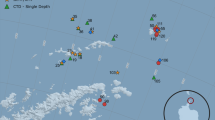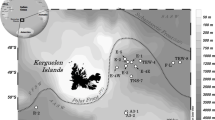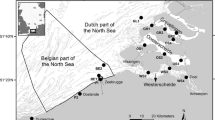Abstract
Detailed determination of Salpa thompsoni elemental composition has been carried out on specimens collected in the Eastern Bellingshausen Sea and at the northern edge of the Weddell Gyre during austral autumn (April and May) of 1996 and 2001. More than 170 Antarctic tunicates S. thompsoni were analysed to determine wet weight (WW), dry weight (DW), ash-free dry weight (AFDW) and elemental composition (C, N content, proteins, carbohydrates and lipids) of different sizes and stages. Dry weight comprised 6.4% (aggregate form) to 7.7% (solitary form) of the WW. AFDW amounted to ~44% of the DW. Carbon and nitrogen contents (Carbon: 17–22%, Nitrogen: 3–5% of the DW) of both aggregate and solitary forms were found to be high relative to data reported in the literature. Although some unidentified organic compounds are not included in our carbon budget, the findings of this study show higher than previously reported nutritional values of S. thompsoni. In spite of this, a shift from a krill-dominated towards a salp-dominated ecosystem would have dramatic consequences for organisms at higher trophic levels.




Similar content being viewed by others
References
Atkinson A, Siegel V, Pakhomov EA, Rothery P (2004) Long-term decline in krill stock and increase in salps within the Southern Ocean. Nature 432:100–103
Bathmann UV (2002) The expedition ANTARKTIS XVIII/5b of the research vessel “Polarstern” in 2001. Rep Polar Mar Res 407:98
Bitterlich G, Gnaiger E (1984) Phytoplanktivorous or omnivorous fish? Digestibility of zooplankton by silvercarp, Hypophthalmichthys molitrix (Val.). Aquaculture 40:261–263
Bruland KW, Silver MW (1981) Sinking rates of Faecal pellets from gelatinous zooplankton (Salps, Pteropods, Doliolids). Mar Biol 63:295–300
Casareto BE, Nemoto T (1986) Salps of the Southern Ocean (Australian sector) during the 1983–84 summer, with special reference to the species Salpa thompsoni. Mem Nat Inst Polar Res 40:221–239
Chiba S, Ishimaru T, Hosie GW, Wright SW (1999) Population structure change of Salpa thompsoni from austral mid-summer to autumn. Polar Biol 22:341–349
Clarke A, Holmes LJ, Gore DJ (1992) Proximate and compositionof gelatinous zooplankton from the Southern Ocean. J Exp Biol Ecol 155:55–68
Donnelly J, Torres JJ, Hopkins TL (1994) Chemical composition of Antarctic zooplankton during austral fall and winter. Polar Biol 14:171–183
Dubischar CD, Bathmann UV (1997) Grazing impact of copepods and salps on phytoplankton in the Atlantic sector of the Southern Ocean. Deep Sea Res II 49:415–433
Duhamel G, Hureau JC (1985) The role of zooplankton in the diets of certain Sub-Antarctic marine fish. In: Siegfried WR, Condy PR, Laws RM (eds) The 4th SCAR symposium on Antarctic biology, Wilderness (South Africa), 12–16 September
Fahrbach E, Gerdes D (1997) The expedition ANT XIII/4–5 of the research vessel “Polarstern” 1996. Rep Polar Mar Res 239:126
Foxton P (1966) The distribution and life-history of Salpa thompsoni Foxton with observations on a related species, Salpa gerlachei Foxton. Discov Rep 34:1–116
Gille ST (2002) Warming of the Southern Ocean since the 1950s. Science 295:1275–1277
Grantham GJ (1977) The utilization of krill. Southern Ocean Fisheries Survey Programme, Food and Agriculture organization of the united nations, United Nations development programme, Rome, 4
Hagen W (1988) On the significance of lipids in Antarctic zooplankton. Rep Polar Res 49:129
Heron AC, McWilliam PS, Dal Pont G (1988) Length-weight relation in the salp Thalia democratica and potential of salps as a source of food. Mar Ecol Prog Ser 42:125–132
Holland DL, Gabbott PA (1971) A micro-analytical scheme for the determination of proteins, carbohydrate, lipid and RNA levels in marine invertebrate larvae. J Mar Biol Assoc UK 51:659–668
Hosie GW (1994) Multivariate analyses of the macrozooplankton community and euphausiid larvae ecology in the Prydz Bay region, Antarctica. ANARE Rep 137:1–209
Huntley ME, Sykes PF, Marin V (1989) Biometry and trophodynamics of Salpa thompsoni Foxton (Tunicata, Thaliacea) near the Antarctic Peninsula in austral summer, 1983–1984. Polar Biol 10:59–70
Iguchi N, Ikeda T (2004) Metabolism and elemental composition of aggregate and solitary forms of Salpa thompsoni (Tunicata: Tahlaicea) in waters off the Antarctic Peninsula during austral summer 1999. J Plankt Res 26:1025–1037
Ikeda T, Bruce B (1986) Metabolic activity and chemical composition of krill and other zooplankton from Prydz bay, Antarctica, during early summer (November–December). Mar Biol 92:545–555
Ikeda T, Mitchell AW (1982) Oxygen uptake, ammonia excretion and phosphate excretion by krill and other Antarctic zooplankton in relation to their body size and chemical composition. Mar Biol 71:283–298
Kashkina AA (1986) Feeding of fishes on salps (Tunicata: Thaliacea). J Ichthyol 26:57–64
Kawamura A (1986) Has marine Antarctic ecosystems changed?—A tentative comparison of present and past macrozooplankton abundances. Mem Nat Inst Polar Res 40:197–211
Kawamura A (1987) Two series of macrozooplankton catches with the H70 V net in the Indian sector of the Antarctic Ocean. In: Proceedings of the NIPR symposium on polar boil, vol 1, pp 84–89
Le Fèvre J, Legendre L, Rivkin RB (1998) Fluxes of organic carbon in the Southern Ocean: roles of large microphagous zooplankton. J Mar Syst 17:35–345
Levitus S, Antonov JI, Boyer TP, Stephens C (2000) Warming of the World Ocean. Science 287:2225–2229
Lowry OH, Rosebrough JN, Farr AL, Randall RJ (1951) Protein measurements with the Folin reagent. J Biol Chem 193:265–275
Madin LP, Cetta CM, McAlister VL (1981) Elemental and biochemical composition of salps (Tunicata: Thaliacea). Mar Biol 63:217–226
Mianzan H, Pajaro M, Alvarez Colombo G, Madirolas A (2001) Feeding on survival-food: gelatinous plankton as a source of food for anchovies. Hydrobiologia 451:45–53
Mizdalski E (1988) Weight and length data of zooplankton in the Weddell Sea in austral spring 1986 (ANT V/3). Reports on Polar Research 55, 72 pp
Nishikawa J, Naganobu M, Ichii T, Ishii H, Terazaki M, Kawaguchi K (1995) Distribution of salps near the South Shetland Islands during austral summer, 1990–1991 with special reference to krill distribution. Polar Biol 15:31–39
Pakhomov EA (1993) Feeding habitats and estimate of ration of gray notothenia, Notothenia squamifrons squamifrons Norman, on the Ob and Lena tablemounts (Indian Ocean sector of Antarctica). J Ichthyol 33(9):57–71
Pakhomov EA, Fronemann PW (2004) Zooplankton dynamics in the eastern Atlantic sector of the Southern Ocean during the austral summer 1997/1998—Part 2: Grazing impact. Deep Sea Res II 51:2617–2631
Pakhomov EA, Fronemann PW, Perissinotto R (2002) Salp/krill interactions in the Southern Ocean: spatial segregation and implications for the carbon flux. Deep-Sea Res II 49:1881–1907
Pakhomov EA, Dubischar CD, Strass V, Brichta M, Bathmann UV (2005) The tunicate Salpa thompsoni ecology in the Southern Ocean. I. Distribution, biomass, demography and feeding ecophysiology (submitted)
Park C, Wormuth JH (1993) Distribution of Antarctic zooplankton 1989, and 1990. Polar Biol 13:215–225
Perissinotto R, Pakhomov EA (1998a) Contributions of salps to carbon flux of marginal ice zone of the Lazarev Sea, Southern Ocean. Mar Biol 131:25–32
Reinke M (1987) On the feeding and locomotory physiology of Salpa thompsoni and Salpa fusiformis. Berichte Polarforsch 36:89
Schindler DW, Clark AS, Gray JR (1971) Seasonal calorific values of freshwater zooplankton, as determined with a Phillipson Bomb Calorimeter modified for small samples. J Fish Res Bd Can 28:559–564
Smith MJ, Dehnel PA (1971) The composition of tunic from four species of ascidians. Comp Biochem Physiol 40:615–622
Voronina NM (1998) Comparative abundance and distribution of major filter-feeders in the Antarctic pelagic zone. J Mar Syst 17:375–390
Wilson RP, Culik BM (1991) The cost of a hot meal: facultative specific dynamic action may ensure temperature homeostasis in post-ingestive endotherms. Comp Biochem Physiol 100:151–154
Acknowledgements
We wish to thank the captain, officers and crew of the RV “Polarstern” for their skilful help throughout both cruises. Special thanks are due to Eberhard Fahrbach (chief scientist during the ANT XIII/4-cruise) who greatly supported the work of a small biology group in the middle of a large group of oceanographers with lots of tasks. We also wish to thank Christian Hamm, Richard Crawford and two anonymous reviewers for carefully reading the manuscript and their very helpful comments. This work was partly funded by a grant of the Alexander von Humboldt-Stiftung for E.A.P.
Author information
Authors and Affiliations
Corresponding author
Additional information
Communicated by O. Kinne, Oldendorf/Luhe
Rights and permissions
About this article
Cite this article
Dubischar, C.D., Pakhomov, E.A. & Bathmann, U.V. The tunicate Salpa thompsoni ecology in the Southern Ocean. II. Proximate and elemental composition. Mar Biol 149, 625–632 (2006). https://doi.org/10.1007/s00227-005-0226-8
Received:
Accepted:
Published:
Issue Date:
DOI: https://doi.org/10.1007/s00227-005-0226-8




